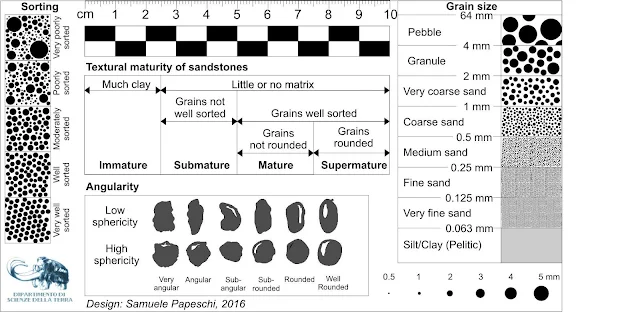Sandstone Maturity: Types and Importance
Sandstone is a sedimentary rock composed mainly of sand-sized (0.0625 to 2 mm) silicate grains. These grains are most commonly quartz, but they can also include feldspar, mica, and other minerals. The grains are cemented together by silica, calcite, or iron oxide. Sandstone is a common rock type, and it is found in a variety of environments, including deserts, beaches, and riverbeds.
Sandstone maturity is a measure of the degree to which a sandstone has been weathered, transported, and sorted. It is characterized by two main components: textural maturity and compositional maturity.
Sandstone maturity can be determined by examining the sandstone under a microscope. The roundness and sorting of the grains can be measured, and the mineral composition of the sandstone can be identified.
Sandstone Maturity - Variations and significance
Sandstone maturity is affected by a number of factors, including:
Composition of the source rock: Sandstone derived from source rocks that are rich in stable minerals, such as quartz, will be more mature than sandstones derived from source rocks that are rich in unstable minerals, such as feldspar.
Distance of transport: The longer a sandstone is transported, the more likely it is to be well-rounded and well-sorted. This is because the sand grains are constantly being abraded and sorted by currents and waves as they are transported.
Depositional environment: Sandstone deposited in high-energy environments, such as beaches and rivers, are more likely to be texturally mature than sandstones deposited in low-energy environments, such as swamps and lakes.
.jpg) |
| The Different Stages of Sandstone Textural Maturity |
Sandstone Maturity Types
There are two main types of sandstone maturity: textural maturity and compositional maturity.
Textural maturity refers to the roundness and sorting of the sand grains. Immature sandstones have angular and poorly sorted grains, while mature sandstones have well-rounded and well-sorted grains.
Compositional maturity refers to the mineral composition of the sandstone. Immature sandstones contain a variety of minerals, including unstable minerals such as feldspar and mica. Mature sandstones are dominated by quartz, which is a very stable mineral.
Textural Maturity
Textural maturity is a measure of the sorting, rounding, and sphericity of the sand grains. A texturally mature sandstone will have well-sorted grains that are well-rounded and spherical. This indicates that the grains have been transported a long distance and have been subjected to a great deal of abrasion.
The Different Stages of Sandstone Textural Maturity
- Immature sandstone rocks have poorly sorted grains that are angular to subangular. They may also contain a significant amount of matrix (clay-sized particles). Immature sandstones are typically deposited close to their source rock and have not been transported very far. They are often found in alluvial fans and deltas.
- Submature sandstone rocks have moderately sorted grains that are subangular to subrounded. They may contain a small amount of matrix. Submature sandstones are typically deposited in environments where the sediment has been transported a moderate distance, such as rivers and lakes.
- Mature sandstone rocks have well-sorted grains that are subrounded to rounded. They contain little or no matrix. Mature sandstones are typically deposited in environments where the sediment has been transported a long distance, such as beaches and deserts.
- Supermature sandstone rocks have very well-sorted grains that are well-rounded to spherical. They contain no matrix. Supermature sandstone are very rare and are typically found in eolian (wind-deposited) environments.
Compositional Maturity
Compositional maturity is a measure of the relative abundance of stable and unstable minerals in the sandstone. A compositionally mature sandstone will have a high proportion of quartz, which is a very stable mineral. Less stable minerals, such as feldspars and micas, will be less abundant.
Compositional maturity is determined by the mineralogical composition of the source rock and the degree of chemical weathering. Sandstones that are derived from sources that are rich in quartz will tend to be more compositionally mature than sandstones that are derived from sources that are rich in less stable minerals.
The Different Stages of Compositional Maturity
The following are the different stages of compositional maturity:
Immature: Immature sandstone contain a high proportion of unstable minerals, such as feldspars, micas, and rock fragments. They may also contain a significant amount of matrix.
Submature: Submature sandstone contain a moderate proportion of unstable minerals. They may contain a small amount of matrix.
Mature: Mature sandstone contain a low proportion of unstable minerals. They contain little or no matrix.
Supermature: Supermature sandstone contain almost exclusively quartz. They contain no matrix.
Significance of Sandstone Maturity
 |
| Sandstone Maturity chart |
Sandstone maturity is a useful tool for interpreting the provenance (source) of a sandstone and the depositional environment in which it was formed. For example, a texturally mature sandstone that is compositionally immature is likely to have been derived from a source that is rich in unstable minerals and that has been transported a long distance. A texturally mature sandstone that is compositionally mature is likely to have been derived from a source that is rich in quartz and that has been transported a very long distance.




%20(1).webp)



